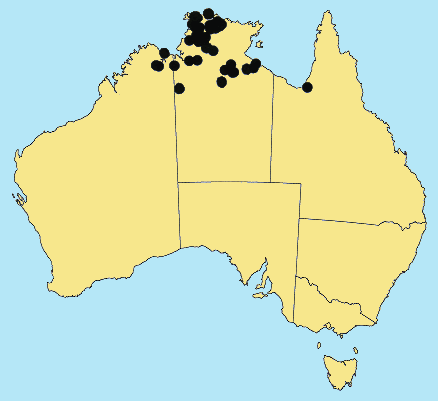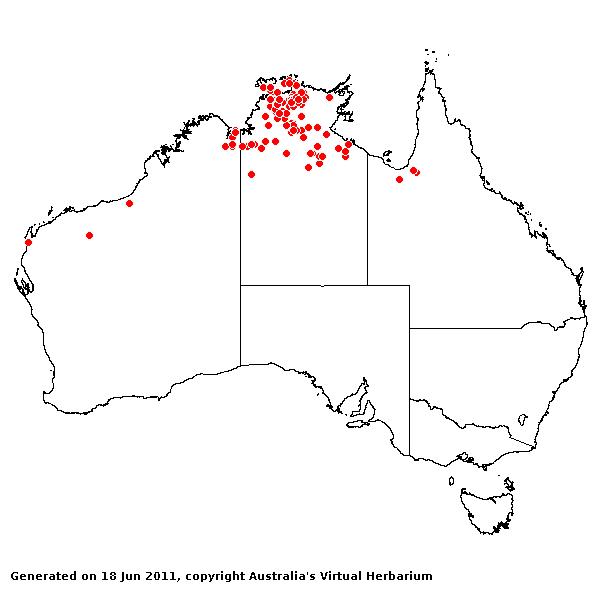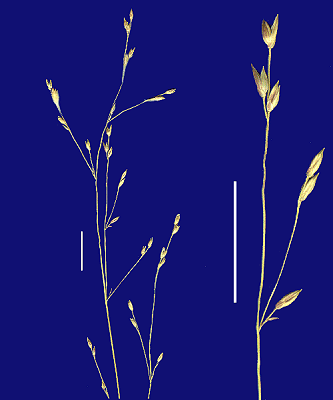Whiteochloa capillipes (Benth.) Lazarides.
Brunonia 1:79 (1978).
Classification. (GPWG 2001) : Subfamily
Panicoideae. Paniceae.
Basionym and/or
Replacement Name: Panicum
capillipes Benth., Fl. Austral. 7: 484 (1878).
Type of Basionym or
Protologue Information: LT: Schultz 806, Australia:
Nort Darwinhern Territory:
Darwin & Gulf Distr.: Port (K; ILT: B). LT designated by Hughes, Bull.
Misc. Inform. 1923: ? (1923).
Key references
(books and floras): [1878] G.Bentham, Flora Australiensis 7 (484 as Panicum),
[1952] C.A.Gardner, Flora of Western
Australia 1 Gramineae (259 as Panicum).
Derivation:
from the Latin capillis (a hair) and pes (foot). The spikelets
are borne on thread-loke pedicels.
Habit. Annual
or perennial. Rhizomes absent or present, short. Culms 60–105 cm tall, 4–6
-noded. Mid-culm nodes glabrous. Leaf-sheaths glabrous on surface or hairy.
Ligule a fringed membrane, a ciliolate membrane, 0.25–0.8 mm long. Leaf-blades
10–25 cm long, 2.5–7 mm wide. Leaf-blade surface scaberulous, glabrous or
indumented.
Inflorescence.
Inflorescence compound, a panicle. Panicle ovate, 10–25 cm long, 5–6 cm wide.
Spikelets.
Spikelets pedicelled. Fertile spikelets 2-flowered, the lower floret barren
(rarely male), the upper fertile, comprising 1 basal sterile florets,
comprising 1 fertile floret(s), without rachilla extension, oblong, laterally
compressed, 2.2–3 mm long. Rhachilla internodes elongated below proximal
fertile floret.
Glumes. Glumes
dissimilar, thinner than fertile lemma. Lower glume ovate, membranous, keeled,
1-keeled, 3–5 -nerved. Lower glume apex muticous or mucronate. Upper glume
oblong, 2.2–2.9 mm long, membranous, without keels, 5–7 -nerved. Upper glume
surface glabrous. Upper glume apex mucronate. Florets. Basal sterile
florets 1, male, with palea. Lemma of lower sterile floret 100 % of length of
spikelet, scarious, 5 -nerved, mucronate.
Fertile lemma 1.7–2.1
mm long, without keel. Lemma apex mucronate. Anthers 3. Grain 1–1.5 mm long.
Continental
Distribution: Tropical Asia and Australasia.
Australian
Distribution: Western Australia, Northern Territory, Queensland.
Western
Australia: Gardner.
Northern Territory: Darwin & Gulf, Victoria
River. Queensland:
Burke.
Notes.
The most obvious diagnostic feature of the species is the open diffuse panicle.
The secondary branches are spreading with relatively long spreading pedicels.
Two species of this genus have racemose primary branches. Reduction of the
primary branches form open paniculate to racemose is of limited taxonomic
significance at the generic level.
Extends to New Guinea and Malaysia. In tropical and
subtropical sub-humid woodlands. Flowers mostly Feb.-June.



